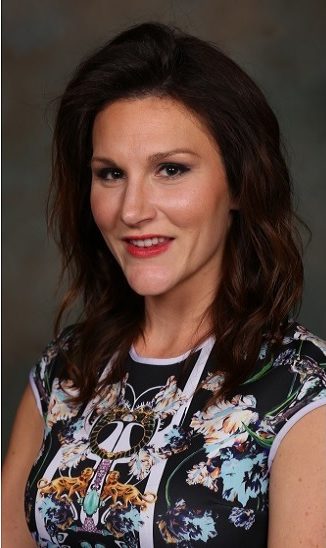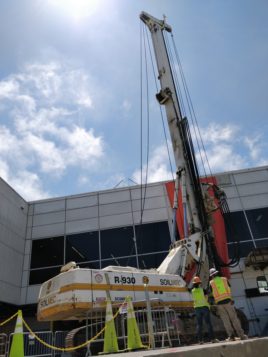
Motivation, satisfaction and all things Women in Construction Operations
By: Chris Maday Schmidt
Kasie Bowden, project superintendent, LEED AP, at Hensel Phelps, lives for a great challenge. She says it’s what makes coming to work so appealing each day. Join Construction Superintendent as Bowden talks about her involvement with Women in Construction Operations, advice for women considering a job in construction and her take on the skilled trade worker shortage, plus the challenges of juggling multiple hats on one project and what makes her tick.
(Q) What was the catalyst that led you to a career in construction?
In college, I studied civil engineering with an emphasis in building science. We had studios similar to the architecture department where we were taught to consider how the building would be put together during design. I loved the planning and creation part of my major. When I started meeting with construction companies in college, I felt an immediate connection. Eleven years later, I’m still pleased with that decision.
(Q) You’ve worked on an airline terminal modernization project and, most recently, on a terminal development project, all at LAX airport. Talk a little about the challenges of working at one of the busiest airports.
At LAX, even though I work for a single client, I have a plethora of stakeholders – the passengers, the airline, LAWA (Los Angeles World Airports), TSA, customs, police department, fire department – the list goes on. Our success at the airport is built on our ability to understand each stakeholder’s needs and communicate, communicate, communicate. Even within LAWA, there are dozens of stakeholders who all have different motivations. Creating a consolidated plan that works for dozens of stakeholders is undoubtedly the biggest challenge, but it’s also the greatest reward when the plan is executed correctly.
(Q) Over the past dozen years, you’ve worn a variety of (hard) hats at Hensel Phelps. What has been your most noteworthy role and why?
On my most recent project, I worked as the design manager during preconstruction. I took the concept design from five sheets of paper to a full blown 90 percent set of documents. Now I get to execute that same design as a project superintendent. I think it’s pretty great that I get the opportunity to wear both office and field hats.
(Q) I understand you’re involved with WiOPS. Share your role with the organization and how your involvement has influenced your career.
WiOPS is a labor of love for me. I’m one of the founding members and am currently the Southern California Chapter board of directors’ vice president. Early on, we all did a lot of the heavy lifting between event planning, website design, funding from our companies and getting set up as a nonprofit. These days, my role is more geared toward future transitions and preparing the next few board members for success.
It’s incredible to see how far we’ve progressed when I look back at where WiOPS started in 2013, wondering whether an organization specifically for women in construction operations was needed in today’s world. Would anyone show up? Would we get the backing from our male counterparts? Would we bring value to the people and the companies we serve? With 600+ members in SoCal, 500+ members in NorCal, as well as interest from people across the country who want to form new local WiOPS chapters, I think we have our answer.
Being a part of WiOPS really helped me keep a pulse on the trends in our industry. This organization has become a part of my “brand” and it’s often a relevant topic of conversation with my coworkers. As a younger employee, before I got involved with WiOPS, I’d sometimes struggle to make meaningful conversation with the executives in my company. Now, I am the resident expert on women in construction subjects, as well as all things related to WiOPS.
(Q) Throughout your career in construction, have you ever felt like a minority or that you’ve had to prove yourself as a female in a traditionally male-dominated industry? If yes, how so?
I don’t think I’ve really had to prove myself any more than the average person. I work hard. I’m dependable. I love building teams focused on trust – that’s where the good ideas come from.
These days, I really only have to tackle the occasional “sticker shock” when I’m introduced as the project superintendent. Or, the first few times I meet with someone, they’ll direct the conversation to the guy standing next to me. But I can’t get upset about that, because that’s just the demographics of the industry we’re in. Statistically, there are considerably fewer women in construction than men and even less in field positions, especially in management roles. I like to think I’ve made the road a little less bumpy for the women traveling behind me.
(Q) What keeps you motivated and satisfied in the workplace?
Building teams and being around people. I love these megaprojects because you get to interact with so many people. I couldn’t work from home or even in a small office. I also really enjoy the satisfaction of solving a complex issue.
(Q) What is your most memorable project to date and what made it stand out?
I had a challenging project a few years back. I think the most difficult jobs are the ones that give you the opportunity to learn, grow and bond with your team members.
(Q) What advice do you give other women who are considering a job in construction?
If you can plan a wedding, you can certainly be a successful manager or superintendent in construction. To pull off a great wedding, you put together a budget and a schedule, down to the minute. You communicate the plan; you even conduct a dry run of the big day. Construction is somewhat similar; only you don’t have to buy drinks for the 150 tradesmen onsite!
Also, just be true to yourself. Sometimes in a sea of stereotypical contractor types, it’s hard to want to walk in with your hair curled, lipstick on and a nice blouse. But if that’s what makes you feel powerful, go for it. I have a light-hearted personality. I enjoy laughing and joking with the craft onsite to build a trusting environment. You don’t see that a lot in construction, so it’s taken me a few years to fully embrace those inner qualities.
(Q) How do you feel careers in the skilled trades could be better promoted?
There are so many great organizations out there like ACE, SkillsUSA and AGC working hard to put an emphasis on growing the skilled labor force.
Yet, we need to continue to get the word out to the future construction workforce about the lucrative and rewarding careers available to them in today’s technologically advanced construction industry. We also need to garner more help from the industry and government to provide training to support this effort. Using marketing channels like social media will help us reach the future workforce. That’s how younger generations get their information and shape their worldview.
There’s already a “National Tradesmen Day” in September each year, although it could be promoted a little better through some of the larger contractors with awards and recognition on the jobsite and social media, similar to Construction Safety Week. I love seeing construction-themed social media posts; it strengthens my connection to my profession and my colleagues in the industry. It really reinforces that drive to create something new every day.
(Q) What are some technological advances you are seeing in the field?
At the airport, we like to share our vision through 3D virtual reality fly-throughs. This isn’t a new technology, but the different ways we use it to communicate to our stakeholders is incredible. For example, we use this technology to show the campus architect our vision for finishes and flow of the new terminal, so she can walk through the terminal and have a clear idea of volume, textures and finishes that will be used. This gives us the ability to present several options at a relatively low cost. We also use the fly-through technology with security officials to show them specific views they’ve requested.
Maintenance access is another hot topic these days. We’re taking it beyond BIM and asking the maintenance supervisors to put on the VR headset and validate access. All of this helps reduce cost of re-work in the field and related schedule impacts.
(Q) What is your favorite pastime when you’re not on the clock?
My husband and I love to travel. Each year we get out of the country with our son. Last year was Japan. We visited Vietnam, Thailand and Cambodia a few years back. This year, Spain.






 Join our thriving community of 70,000+ superintendents and trade professionals on LinkedIn!
Join our thriving community of 70,000+ superintendents and trade professionals on LinkedIn! Search our job board for your next opportunity, or post an opening within your company.
Search our job board for your next opportunity, or post an opening within your company. Subscribe to our monthly
Construction Superintendent eNewsletter and stay current.
Subscribe to our monthly
Construction Superintendent eNewsletter and stay current.